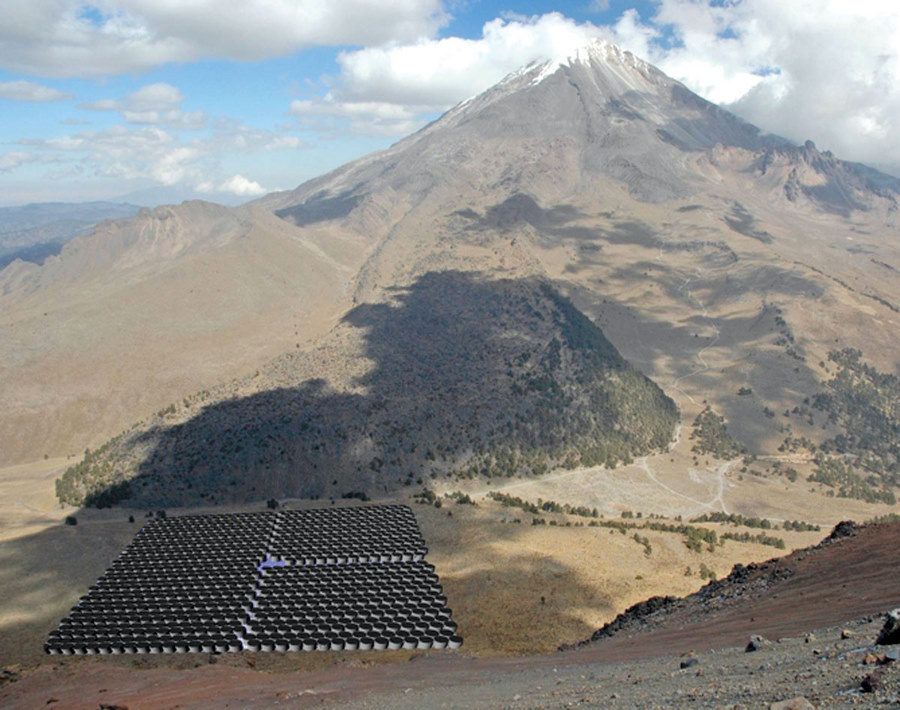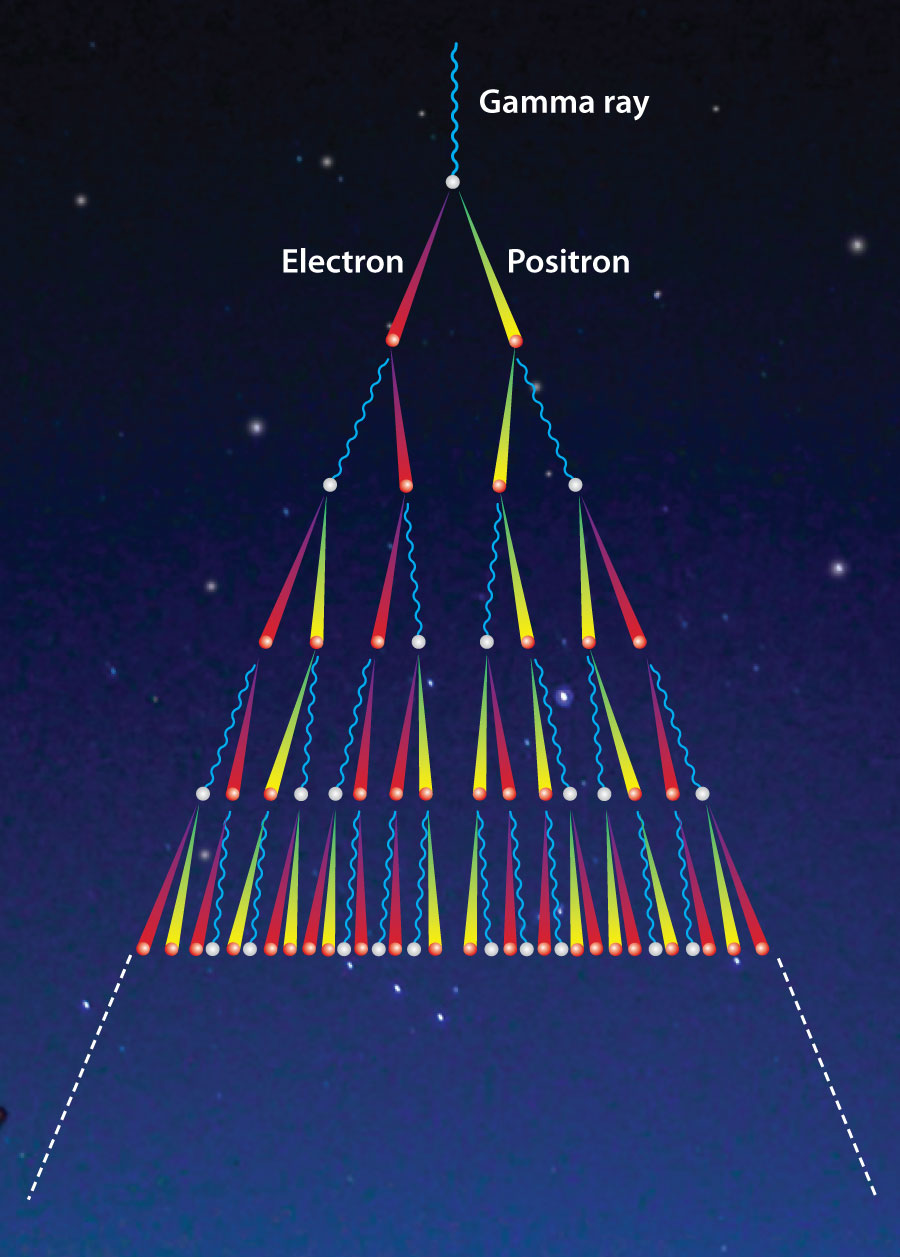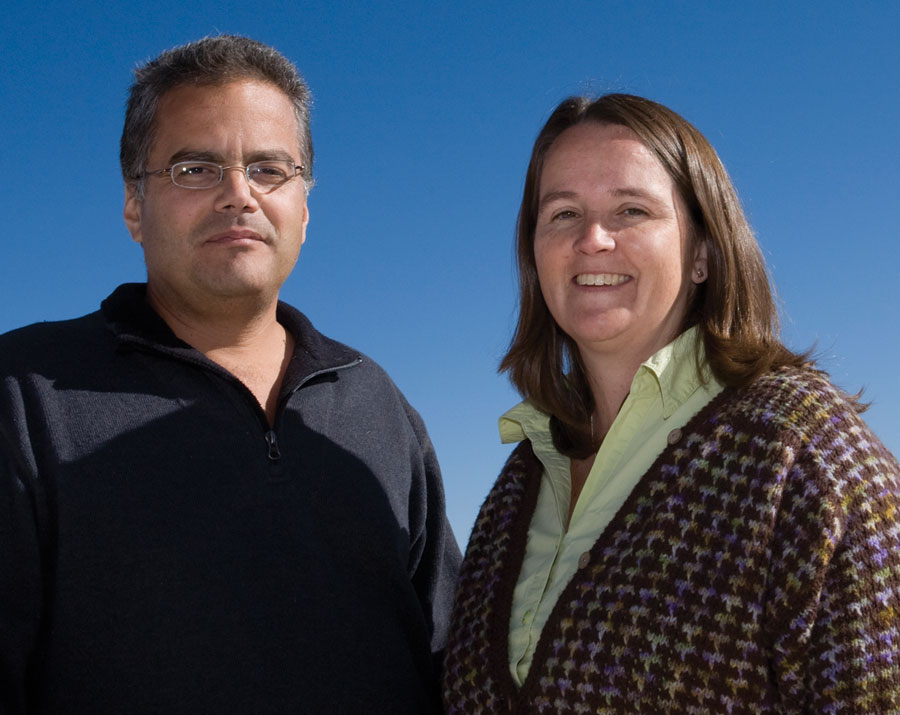|
|
|
|
The Miracle Array HAWC and the Future New window on the extreme universe ..
The Miracle Array
"With all its success, Milagro provided only a proof-of-principle for the basic technique of using Cerenkov radiation in water to detect shower particles," says Dingus. "Our experience over the last decade and our computer simulations of Milagro's performance convinced us that we could build a much more sensitive detector, and with support from the Laboratory-Directed Research and Development program, we've designed it." Funding is being sought from the National Science Foundation and Mexican institutions for the new array: HAWC, for High Altitude Water Cerenkov array. It will be built on the shoulder of Sierra Negra, Mexico's highest peak. At 13,500 feet, HAWC will be 4,000 feet higher than Milagro was. At the higher altitude, the number of particles reaching the ground from a shower of a given energy is 5 times higher than that at the Milagro altitude. The HAWC PMTs will be distributed one per tank in 900 water-filled tanks placed place side-by-side over an area about 10 times that of the Milagro pond. Because each PMT will be in its own large tank, the light from each shower particle will be seen by only one PMT, which will allow more-accurate determination of the shower energy. The increase in altitude, the larger area, and the optical isolation of the PMTs will increase the overall sensitivity 10 to 15 times—high enough to detect many new gamma-ray sources and to monitor the variability of these sources. Atmospheric Cherenkov telescopes have detected, at distances of billions of light-years, extragalactic sources that flare in only a few minutes, but they have been able to monitor only a few sources for a small amount of time. HAWC will observe the TeV sky every day, and its higher sensitivity will increase the energy range over which these sources can be detected. Milagro found a few sources, but HAWC will add important details for understanding the physical mechanisms in nature's high-energy particle accelerators. The enormous progress in gamma-ray astronomy over the past decade has fueled intense interest in future instruments. Large investments are planned for the next generation of atmospheric Cherenkov telescopes. Meanwhile, Los Alamos has blazed a new path that will culminate in HAWC, a highly sensitive all-sky survey instrument able to reveal the transient high-energy universe. Sinnis summarizes its promise this way: "With HAWC, we will be in a unique position to close in on the century-old question of the origin of cosmic rays." Necia Grant Cooper
|
|
| INTRO
A small manmade pond in northern New Mexico's Jemez Mountains was recently transformed into something of a miracle—a unique gamma-ray telescope, called Milagro, that has identified new regions of violent activity in the nearby universe. This water-based telescope is a precursor to a future, even more sensitive tool for peering into the high-energy universe and unveiling nature's cosmic accelerators.
Artists' conception of a particle shower generated
by a high-energy gamma ray (red) coming from the Crab nebula, the brightest
gamma-ray source in the sky. The composite image of the Crab Nebula, reproduced
from the HubbleSite Gallery, shows an x-ray image of the central pulsar
wind nebula (light blue) within the combined optical and infrared images
of the expanding envelope of the supernova remnant.
Composite image of Crab Nebula courtesy
of NASA, ESA, CXC, JPL-CalTech, J. Hester and A. Loll, Arizona State Univ.,
R. Gehrz, Univ. Minn., and STSCI.
|
|
| Are these gamma-ray sources
generating cosmic rays?
When we gaze at the stars, the light we see is radiation from hot gas on the stellar surfaces, continuously heated by nuclear fusion at the centers of those stars. Recently, scientists at Los Alamos have developed a technique to survey the entire overhead sky for sources of much higher energy radiation, gamma rays at energies trillions of times higher than the energy of the starlight we see with our eyes. Those gamma rays come from regions of violent activity, where unknown mechanisms accelerate matter to high energies. They come from the active centers of distant galaxies, where stars are being swallowed up by supermassive black holes, and solar-system-size clouds of hot ionized matter are being ejected in narrowly focused jets moving at nearly the speed of light. They also come from expanding nebulae left over from exploding stars (supernovae), wind nebulae streaming from compact neutron stars, and stellar-size objects that produce short, ultrabright bursts of gamma rays. Understanding these rapidly changing regions and how they generate high-energy gamma rays presents us with some of the most-difficult problems in modern physics. For example, are these gamma-ray sources also generating cosmic rays, the very high energy charged nuclei that streak across the galaxy? "The regions emitting gamma rays have intense gravitational, electric, and magnetic fields," says Brenda Dingus, current team leader of the Milagro project, the high-energy gamma-ray experiment at Los Alamos. "In our work at Milagro, we and our university collaborators have been surveying the sky for the very highest energy gamma rays, those with energies of 10- to 100-trillion electron volts (TeV) and higher. These gamma rays can tell us the most about these violent regions and thereby put constraints on our ideas about the acceleration mechanisms that might be taking place there." Locating these gamma-ray sources might also help solve the century-old mystery of how and where cosmic rays are formed. Gamma rays, like visible light, travel to Earth in straight lines and therefore reveal their place of origin. In contrast, the electrically charged cosmic rays get deflected by the magnetic fields in our galaxy and arrive at Earth from all directions with no indication of where they come from. "Cosmic rays form a large, uniform background. To detect a gamma-ray source, we must detect a significant number of gamma rays coming from a particular direction, a number larger than the fluctuations in the cosmic-ray background," continues Gus Sinnis, co-spokesperson for Milagro and leader of the Neutron Science and Technology Group. "Because gamma rays are likely ‘fellow travelers' of cosmic rays, in the sense that they are produced with them or by them, a high-energy gamma-ray source is likely to be at or near a cosmic-ray source. If one finds the former, one is likely closing in on the latter."
Artist's conception of a particle shower generated
by a high-energy gamma ray (red) coming from the Crab Nebula, the brightest
gamma-ray source in the sky. The composite image of the Crab Nebula, reproduced
from the HubbleSite Gallery, shows an x-ray image of the central pulsar
wind nebula (light blue) within the combined optical and infrared images
of the expanding envelope of the supernova remnant. Composite image of
Crab nebula courtesy of NASA, ESA, CXC, JPL-Caltech, J. Hester and A. Loll
(Arizona State Univ.), R. Gehrz (Univ. Minn.), and STSCI
SOURCE: Los Alamos National Labs |
|
| Milagro's Ground-based, Large-area
Array of Particle Detectors is Highly Sensitive Scanner
Until the Milagro experiment, gamma-ray astronomers had great difficulty detecting sources of gamma rays with energies as high as 10 to 100 TeV. To detect a source of gamma rays in that energy range, one must detect at least 10 to 20 such gamma rays per day coming from a particular direction. That's an impossible task for satellite-borne detectors. Their area is so small that the number of very high-energy gamma rays intercepting the detector's small area per year goes down to almost zero. The ground-based gamma-ray telescopes known as atmospheric Cherenkov telescopes are much larger, but they cannot detect gamma rays directly because gamma rays never reach the ground. Instead, gamma rays produce a shower of secondary particles when they enter Earth's atmosphere (see figure below), and the atmospheric Cherenkov telescopes pick up the (Cherenkov) light radiated in the wake of those secondary particles. Those telescopes have been very successful and were the first to discover a cosmic source of TeV gamma rays (the Crab Nebula, shown in the opening illustration). However, their narrow field of view, combined with the requirement for moonless, cloudless nights, restricts their viewing to a discrete number of directions and a limited viewing time (50 hours per year) in each direction. They therefore have difficulty detecting sources that emit gamma rays above 10 TeV or that are spread over a wide area in the celestial sky. These limitations on field of view and observation time can be overcome by a ground-based array of particle detectors spread over a large area. This large-area array can operate around the clock and simultaneously view the entire overhead sky. However, it will detect only the shower particles that survive to ground level, and of those, only the small fraction, typically less than 1 percent, that intercept the sparsely distributed detectors. The rest fall, you might say, between the cracks. Large-area arrays are therefore sensitive to the showers from gamma rays that are 100 TeV and above because those showers cover the largest areas and generate the largest numbers of particles: millions of particles and more. Unfortunately, the number of 100-TeV gamma rays entering Earth's atmosphere is so low that the enormous Cygnus array at Los Alamos and the Chicago Air Shower Array, covering over 200,000 square meters in Dugway, Utah, failed to detect a significant number of 100-TeV showers coming from any particular direction. Thus, no sources were found. The Los Alamos team concluded that a successful ground-based array would have to be sensitive to showers from much lower-energy gamma rays—down to 0.1 TeV. At that energy, the showers are millions of times more numerous, but each shower contains only thousands as opposed to millions of particles, and many particles would be absorbed before reaching the ground. The array would therefore have to detect almost all the particles that reach the ground, which meant creating an array with end-to-end detectors. That approach would be way too expensive. SOURCE: Los Alamos National Labs |
|
| A Unique Gamma-ray Telescope,
Called Milagro
The impasse provided an important moment for Los Alamos' Todd Haines. When still a graduate student at the University of California, Irvine, Haines had begun working on a new approach to detecting gamma-ray showers—an approach involving water. Shower particles that intercepted a huge tank of water would streak through the water at nearly the speed of light, setting electrons in the water in motion. Those electrons would radiate light, and because light has only two-thirds its normal speed when going through water, the light would trail behind the speeding particle and form a wide-angle (41-degree) wake, like the bow wave formed by a boat traveling faster than the speed of water waves or like a supersonic plane's shock wave, which creates the sonic boom. Any light detector within the wake would detect the shower particle. Now, if an array of hundreds of light detectors (photomultiplier tubes, or PMTs) were immersed in a mammoth tank, an arrangement could be found that guaranteed that light from every particle entering the pond would be detected. In addition, the array could operate during the day if covered with a light-tight tent that kept out every ray of sunshine. The idea was very promising, but with no funds to construct the water tank, it was just another new idea. Then one day Darragh Nagle, a Los Alamos nuclear physicist, burst into Haines' office and announced, "I know where we can build your project." Nagle took Haines to Fenton Hill in the Jemez mountains west of Los Alamos. There an abandoned manmade pond, once used as a holding tank for an experimental geothermal well, now stood ready for another purpose. Thus began Milagro (Spanish for "miracle"), in which a small pond was transformed into a new window on the universe, one that would view the most-extreme phenomena in our galaxy and regions nearby. The Fenton Hill pond was 195 feet by 260 feet and 26 feet deep. It was smaller than desired but could be supplemented by small water tanks outside the pond—outriggers—each containing a PMT. The outriggers would be spaced over an area 10 times the size of the pond. For showers that intercepted the pond only partially, those outriggers would detect the central core of a shower, thereby enabling accurate reconstruction of the shower direction. "The outriggers increased Milagro's sensitivity by a factor of two, and that made all the difference. We went from barely seeing the Crab Nebula, the brightest gamma-ray source in the northern sky, to discovering new sources of TeV gamma rays in our galaxy and finding a path towards proving that certain sources are cosmic-ray sources," says Sinnis.
SOURCE: Los Alamos National Labs |
|
| Milagro Yields the Unexpected
From 2000 to 2008, Milagro detected over 200 billion showers from both gamma rays and cosmic rays, collected at the rate of 1,700 showers per second. Each was recorded electronically, analyzed on the spot, and characterized by statistical features that were saved for further analysis. The analysis produced the most-sensitive survey of the TeV sky to date and led to several surprises. First were the five bright sources of TeV gamma rays (in the figure above, the sources with dark centers), with average gamma-ray energies of 12 TeV, standing out loud and clear above the uniform background of cosmic rays, and four less-prominent candidates. Several of these sources overlapped the much lower energy gamma-ray sources that were discovered 5 to 10 years earlier by satellite-borne gamma-ray detectors. Ground-based atmospheric Cherenkov telescopes had not seen them, despite having searched for TeV gamma rays in the directions of these known sources. One explanation was that some Milagro sources are spatially extended, up to a few degrees in diameter, making them difficult to detect with narrow-view telescopes. Of these, some turned out to be nearby pulsar wind nebulae, exotic nebulae left over from supernovae that have at their center a neutron star pulsar creating a wind of high-energy particles (see opening illustration showing the Crab Nebula). A follow-up search with longer observation times by the HESS atmospheric Cherenkov telescope array in Namibia resulted in detection of one of Milagro's sources. The HESS result not only confirmed Milagro's measurement of the total flux of TeV gamma rays but also determined that this source was unusually bright at the very highest energies at which Milagro has its greatest sensitivity. Another major Milagro discovery was a surprisingly large number of TeV gamma rays coming from an extended region of the Milky Way known as Cygnus. The expected number is calculated by assuming the gamma rays are produced by the uniform background of cosmic rays impinging on the interstellar matter and radiation in the Cygnus region. However, Cygnus contains an unusually high number of objects (supernova remnants, young stellar clusters, and stars called Wolf-Rayet stars that emit large winds) that could be cosmic-ray sources. "The excess of gamma rays detected by Milagro could be the smoking gun for a recent cosmic-ray source, an explosion of a star within the region in the past 10,000 years," explains Sinnis. Milagro has taught us to "expect the unexpected" says Dingus. "When we open a new window on the universe, the biggest discoveries are not the ones predicted."
SOURCE: Los Alamos National Labs |
|
| FAIR USE NOTICE: This page contains copyrighted material the use of which has not been specifically authorized by the copyright owner. Pegasus Research Consortium distributes this material without profit to those who have expressed a prior interest in receiving the included information for research and educational purposes. We believe this constitutes a fair use of any such copyrighted material as provided for in 17 U.S.C § 107. If you wish to use copyrighted material from this site for purposes of your own that go beyond fair use, you must obtain permission from the copyright owner. | |
|
|





